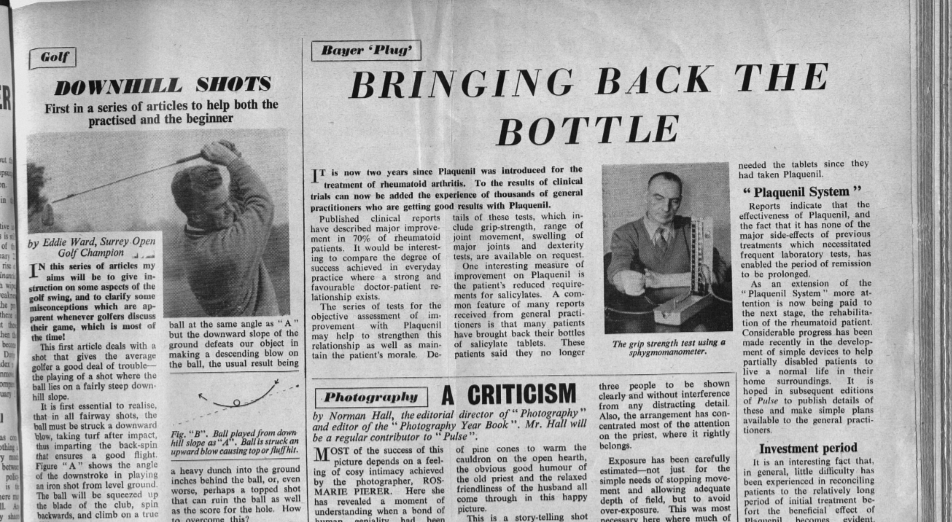Pulse recently sent me an article from their very first edition, which came out in 1960 and contained an article on hydroxychloroquine (Plaquenil) and its use in rheumatoid arthritis (RA). The drug had been released two years previously and the article claimed improvement in 70% of cases.
Click the image to see the full article on Plaquenil – as well as get a few golf tips!
The magazine itself is fascinating – most of the rest of the page on Plaquenil is taken up with an article on improving one’s golf swing, and a further piece reviews Iceland as a holiday destination.
The editorial brief at the front of the magazine reassures that ‘the two main doctor interests – golf and photography – will have their place.’
How much things have changed, and for the better! Pulse magazine is now a valued resource of clinical and financial information for GPs and no longer assumes that we all have enough time to play golf (or would even be interested in it!).
I first became interested in rheumatology in 1981 while at medical school in Manchester. My first clinical attachment was on a rheumatology ward at Hope Hospital where there were many inpatients with varying degrees of long-standing rheumatoid disease. Most had terrible joint deformities and needed aids to help them dress and make meals. The focus was on ‘rehabilitation’ with hydrotherapy and occupational therapy, as most of the drug treatments didn’t work very well. We were using intramuscular gold injections and steroids back then.
My first house job was also on a rheumatology ward at Manchester Royal Infirmary in 1984 where one of our main tools was to refer people for a week or two at Buxton Hospital to be treated in the healing spring waters. It’s hard to believe that this was all we could do back then, apart from monthly gold injections with their side effects of skin rashes and kidney disease.
In this time, patients faced a lifetime of debilitating systemic disease and progressive joint deformities that meant that normal life was impossible. I particularly remember one man with ankylosing spondylitis who was admitted for disease management. His disease was so active that his haemoglobin was only 8.0 g/dl. We had no treatments apart from phenylbutazone and physiotherapy. He refused a blood transfusion as he knew that it would make him feel better and increase his exercise capability and he might lose his disability benefit. To my knowledge, this was the first time I had ever discussed benefits with a patient and the whole benefits system had received little attention in my five-year undergraduate training. I had also never encountered a patient whose life was so constrained by his disease and the effects of the social care system.
By 1991 I was a GP in Shropshire and started work as a clinical assistant in rheumatology at the Robert Jones and Agnes Hunt Hospital (RJAH) in Oswestry and also the Princess Royal Hospital in Telford (the pay was £40 per week gross). Disease-modifying antirheumatic drugs had been introduced by then and hydroxychloroquine was certainly one of our drug treatments. We reserved it for milder disease as it was not as effective as sulphasalazine or methotrexate. These were the treatments of choice but there was no urgency in starting them, and we would often see a new patient and do nothing apart from refer for physio and review after six months. DMARDS were then only started if the disease was felt to be progressive. Of course, we now know that this initial six months is the most important time in the disease progress and that early intervention, within weeks of disease onset, can halt the pathological process in its tracks. This prevents disease progression and the long-term joint damage seen back then.
We would often admit patients to the RJAH for two weeks of intensive physiotherapy, hydrotherapy and bed rest – which worked – but as soon as people were out and about doing their normal job and living a normal life, the disease returned with a vengeance.
We were also very slow at increasing the dose of methotrexate, often increasing by 2.5mg every three months so that patients rarely took more than 10mg per week. This dose is considered very low in modern regimes; patients are now started in 15mg and escalated up rapidly to 25mg weekly.
Not surprisingly, our patients carried a huge burden of disease and deformity. I still see a lovely 68-year-old patient who I first treated in 1991 in the hospital clinic; she has had multiple surgeries on her hands and wrists, and they are now virtually useless with ligament rupture and joint subluxation. Her feet are similarly deformed. She could not work beyond her late thirties, never married and could never consider a pregnancy or even a holiday abroad. Despite all this, she is amazingly positive and cheerful.
I am very pleased to report that since the first NICE guideline in 2009 about the management of RA in adults, which I was fortunate enough to be involved with, the treatment regime has been completely revised.
We now start treatment as early as we can after diagnosis. Diagnosis is much prompter, as we now have diagnostic ultrasound to detect the earliest signs of synovitis, often before changes are visible to the naked eye.
Treatment regimens are much more aggressive, with higher dose DMARDS, usually methotrexate, bridging steroid therapy to prevent joint damage as the DMARDS take effect, and sometimes combination DMARD therapy.
A treat-to-target approach is used to titrate DMARDs up quickly to bring the disease under control and I rarely see anyone with joint deformities in the rheumatology clinic now. The comorbidities of cardiovascular disease, osteoporosis, vasculitis, renal and lung disease and depression are also much less common as disease activity is much better controlled.
Ten years ago, biologic drugs were introduced based on monoclonal antibodies. In 1982 I did an intercalated oncology and experimental immunology BSc and monoclonal antibodies were being developed in the Paterson labs where I studied, attached to the Christie Hospital in Manchester. It was an exciting time developing these new molecules with such amazing potential and I felt greatly privileged to have been around at this time and see how far they have gone.
Nowadays, if patients do not respond quickly to two different DMARDS, they are offered biologic treatments, which can work amazingly well and very quickly.
Modern immunology techniques now allow more targeted disease treatment with synthetic DMARDS such as aprimelast, which target the molecules involved in inflammation in psoriatic arthropathy and spondyloarthritis. The immunological pathway for these diseases is completely different to the rheumatoid pathway and different cytokines are involved. Targeted therapies have revolutionised the treatment of these rheumatological conditions. We now also have more targeted biologic drugs for RA, such as rituximab which works by eradicating immature B cells.
In my working lifetime I have been so lucky to witness and be part of the evolution of newer treatments for rheumatic diseases, which have led to much better outcomes for patients. Who knows what will happen in the next forty years!
Dr Louise Warburton is a GPSI in rheumatology, associate medical director of Shropshire Community NHS Trust and clinical lead for Telford MSK service


















